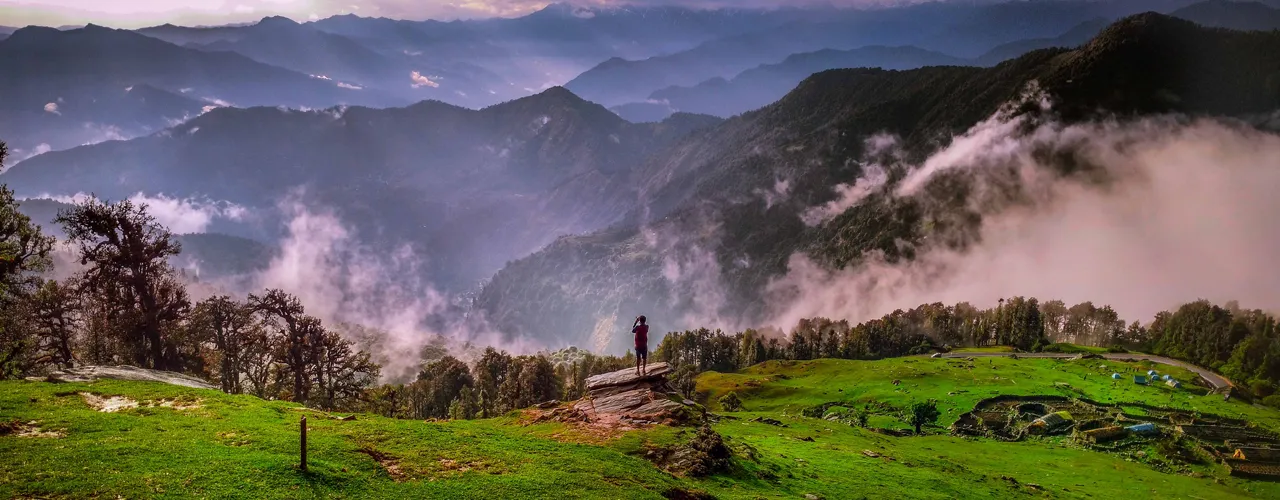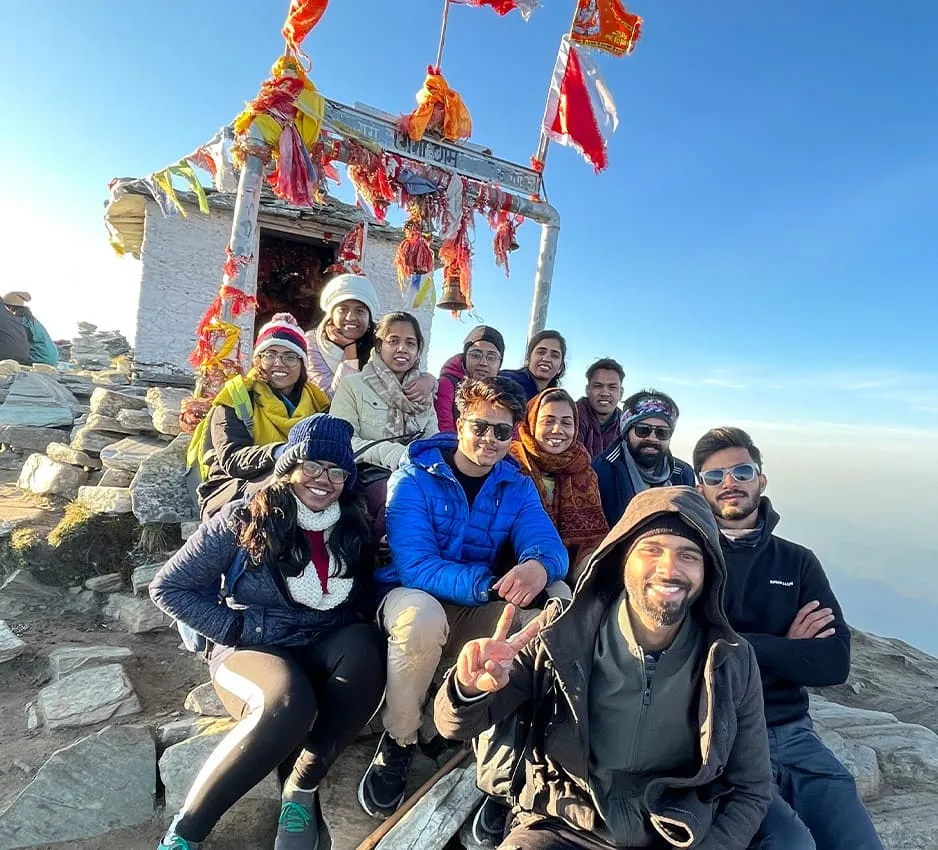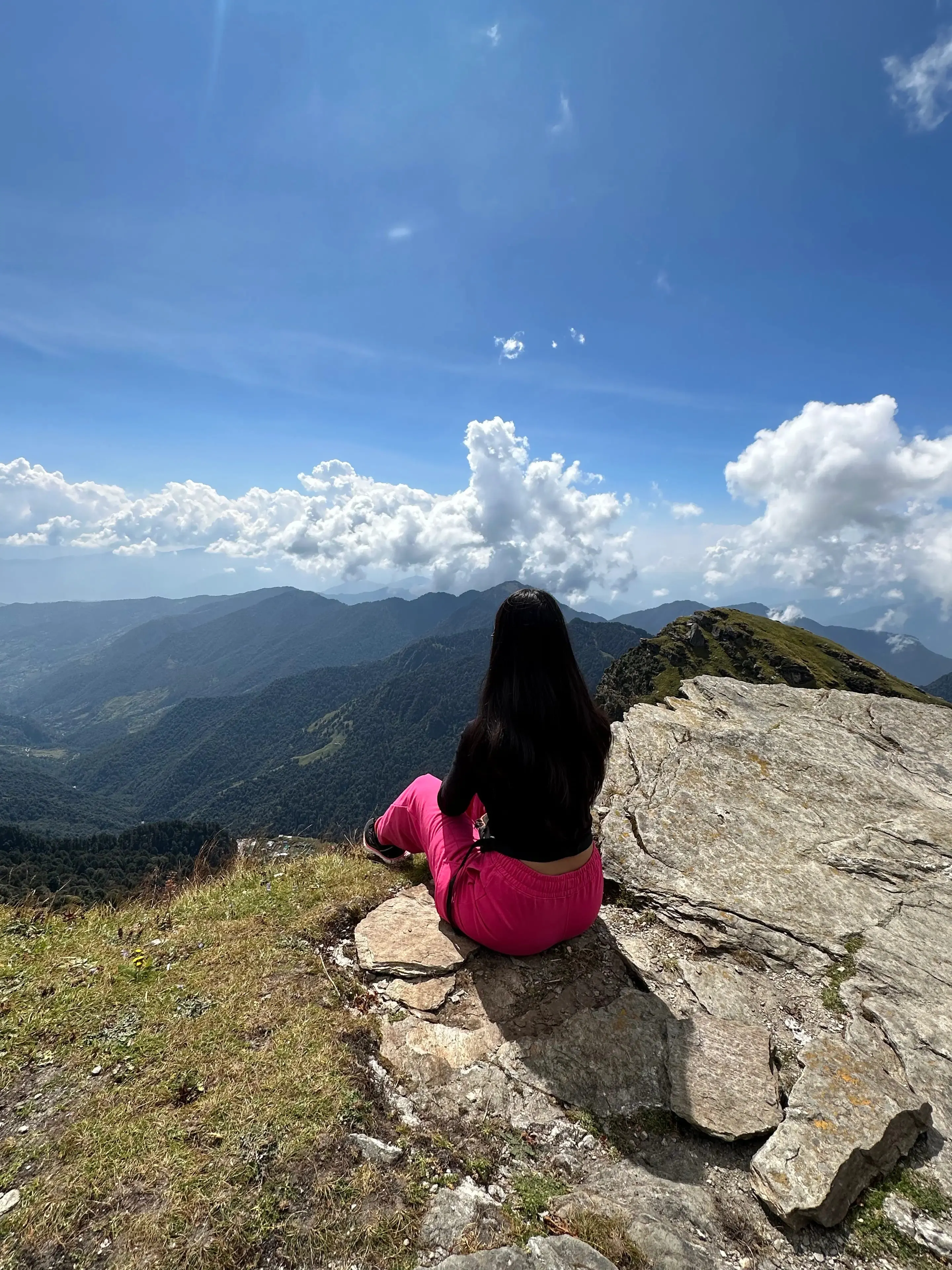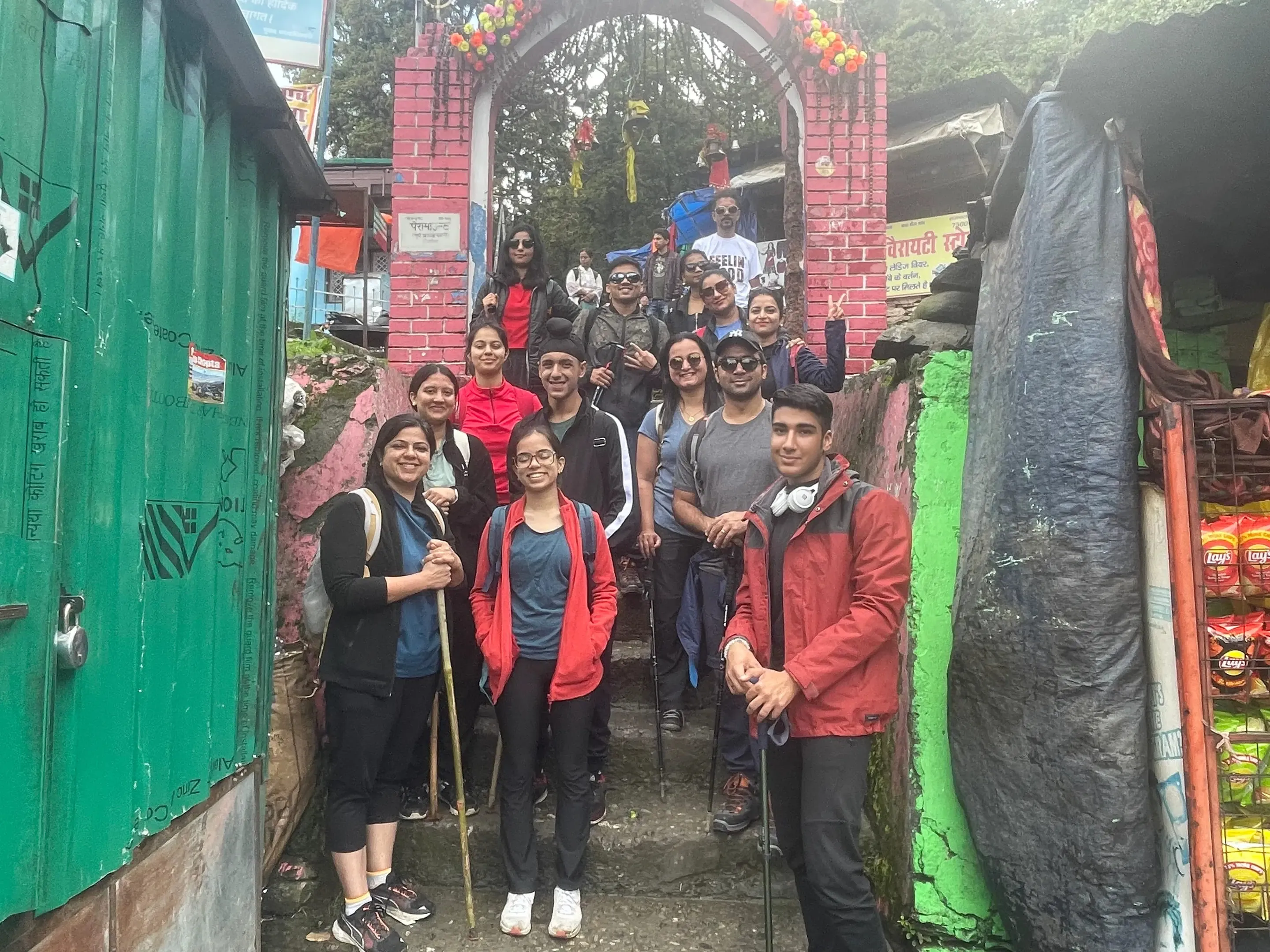
Visit Shiva Amongst The Clouds
Location
Uttarakhand
Duration
3D/2N
Distance
29 Km approx
Altitude
13,000 ft
Difficulty
Easy-Moderate
Price
₹ 6,999/- Onwards
Overview
Tungnath, nestled in the Indian Himalayas, is the highest Shiva temple in the world, situated at an elevation of approximately 3,963 meters (13,000 feet) in Uttarakhand’s Rudraprayag district. It is one of the sacred Panch Kedar temples, believed to be established by the Pandavas from the Mahabharata as part of their journey to atone for sins committed during the war. The temple is an architectural marvel, constructed in a traditional North Indian style using local stone and featuring intricate carvings.
Tungnath is a popular trekking destination for adventure enthusiasts, with a moderately challenging trail that begins at Chopta and offers panoramic views of nearby Himalayan peaks, including Nanda Devi, Trishul, and Chaukhamba. The trek, about 4 kilometers, is scenic, passing through lush rhododendron forests and alpine meadows. Tungnath remains closed during winter due to heavy snowfall, with the deity moved to nearby Mukkumath village for worship.

Brief Itinerary Your day-to-day breakup of activities.
DAY 1 : Drive to Chopta
- 264 km drive from Delhi to Chopta
- 10-12 hours drive

Welcome to Chopta Chopta, often called the "Mini Switzerland of Uttarakhand," is a picturesque hill station nestled in the Himalayas. Known for its lush meadows, dense forests, and stunning views of peaks like Nanda Devi and Trishul, it serves as the base for treks to Tungnath Temple and Chandrashila Summit.
Chopta, situated in the Garhwal region of Uttarakhand, India, is a serene and scenic hill station often called the "Mini Switzerland of Uttarakhand." Perched at an elevation of approximately 2,680 meters, Chopta is part of the Kedarnath Wildlife Sanctuary and is surrounded by dense pine, deodar, and rhododendron forests. This idyllic location offers breathtaking views of snow-capped Himalayan peaks, including Trishul, Nanda Devi, and Chaukhamba, making it a popular destination for nature enthusiasts, photographers, and trekkers.
Chopta serves as the base for treks to Tungnath, the highest Shiva temple in the world, located at an altitude of 3,680 meters, and further up to the Chandrashila Summit at around 4,000 meters. The trek, moderate in difficulty, rewards adventurers with 360-degree views of the surrounding peaks. Chopta is an all-season destination: summers offer pleasant weather and lush greenery, while winters bring a blanket of snow, transforming it into a wonderland for winter trekking and camping.
The area is home to diverse flora and fauna, including rare birds and musk deer, attracting wildlife enthusiasts and bird watchers. With its pristine beauty and peaceful atmosphere, Chopta is a perfect escape for those seeking solitude and adventure amidst nature.
Chopta
8,790 ft
Stay
Homestay/Guesthouse
Food
Evening Tea & Snacks, Dinner
DAY 2 : Trek from Chopta to Tungnath to Chandrashila and return to Chopta
- Trek Distance: 6-7 km/5-6hrs
- Trail Type: Gradual to Moderate ascent
- The trek starts from Chopta and winds through dense forests and scenic alpine meadows.

Welcome to Chandrashila Chandrashila, meaning "Moon Rock," is a summit in Uttarakhand located at around 4,000 meters above sea level. Known for its panoramic 360-degree views of the Himalayan peaks, including Nanda Devi, Trishul, and Chaukhamba, Chandrashila is a revered spot, believed to be where Lord Rama meditated after defeating Ravana.
Chandrashila, meaning "Moon Rock," is a striking summit in the Garhwal Himalayas of Uttarakhand, located at an elevation of approximately 4,000 meters (13,000 feet). This peak offers one of the most breathtaking panoramic views in the Indian Himalayas, encompassing major peaks like Nanda Devi, Trishul, Chaukhamba, and Kedarnath. Chandrashila is a popular destination among trekkers and pilgrims alike, with its combination of natural beauty, spiritual significance, and moderate trekking difficulty.
The trek to Chandrashila typically begins at Chopta, passing through the revered Tungnath Temple—the highest Shiva temple in the world. This 5-kilometer trek route is well-paved, making it accessible to both novice and experienced trekkers. The journey from Tungnath to Chandrashila is steep, but the summit rewards hikers with awe-inspiring 360-degree views, especially stunning at sunrise and sunset when the snow-capped peaks glow in vibrant hues.
Chandrashila holds cultural and mythological importance, as it is believed that Lord Rama meditated here after defeating Ravana, and some accounts suggest that Lord Shiva himself blessed the summit. This blend of spirituality, alpine scenery, and adventure makes Chandrashila a must-visit destination for those exploring the Himalayas, appealing to nature lovers, spiritual seekers, and adventurers alike.
Max Altitude
13,000 ft
Stay
Dome Tent
Food
Morning Tea/Coffee, Breakfast, Packed Lunch during trek, Evening Tea & Snacks, Dinner
DAY 3 : Drive from Chopta to Sari | trek to Deoriatal & back | Drive to Delhi
- Trek Distance: 264 km/10-12hrs
- Trail Type: Moderate to Steep ascent to stepp descent

Welcome to Deoriatal Deoriatal is a pristine, high-altitude lake near Chopta in Uttarakhand, located at around 2,438 meters (8,000 feet). Surrounded by lush forests and offering mirror-like reflections of the Chaukhamba peaks, Deoriatal is popular among trekkers and nature lovers. Its serene ambiance and scenic views make it an ideal getaway.
Max Altitude
8,000 ft
Food
Morning Tea, Breakfast, Hot Lunch during trek, Evening Tea & Snacks, Dinner
Trek Highlights The must do experiences that you can cross off your bucket list

Mini Switzerland of Uttarakhand
Some people call it the "Mini Switzerland of Uttarakhand," but that might not do it justice. This place has its own unique beauty, with a distinct identity that includes its vast landscapes, diverse flora and fauna, rich wildlife, and vibrant local culture.
.webp)
360° Himalayan range view
Get a 360° panoramic view of the most prominent Himalayan peaks, including Swargarohini, Black peak, Ranglana, Gangotri ranges, and more.

Highest Lord Shiva Temple
Visit Tungnath Temple, the highest Shiva temple in the world and, surprisingly, the easiest one to reach. It is also one of the Panch Kedar dedicated to Lord Shiva.

Lake with the view of Himalayan ranges
Get beautiful reflections of Chaukhamba and other Himalayan peaks, including the Kedarnath Dome, Meru, and Sumeru, on Deoriatal Lake.
How To Reach
To Delhi
Major bus terminals in Delhi are:
- Kashmere Gate ISBT
- Anand Vihar ISBT
- Sarai Kale Khan ISBT
Price And Batches
Select Package Options
Please Select A Date
Please Select A Tour Package
Total Travellers
Price Total
Costings
- Select a package to see costing.
Why Trek With US?
Certified Guides
CommitmentOf Safety
Unique And Customized Experiences
Promote Sustainability
Quality Over Quantity
Inclusions And Exclusions
Inclusions:
- • Transportation: Based on your package.
- • Accommodation: Guest house will be arranged in Chopta on Day 1 . Rest tents will be provided.
- • Meals: Nutritious and healthy vegetarian meals from dinner on Day 1 to breakfast on Day 3.
- • Forest permits and camping charges: For entry to the wildlife area and camping in designated areas.
- • Equipment: From tents, sleeping bags, and mattresses to micro-spikes and gaiters.
- • Support staff: Professional trek guides, cooks, and support staff will accompany you.
- • Porter and mule charges to carry camping equipment (not personal luggage).
- • Medical Amenities - First Aid Kits , Oxymeters , Oxygen Cylinders.
Exclusions:
- • 5% GST
- • Personal Expenses: Any expense of a personal nature such as additional meals, snacks, etc.
- • Trek/Travel Insurance: The cost of travel insurance is not included.
- • Costs due to unforeseen incidents: Additional costs incurred due to weather or roadblocks.
- • No food and accommodation till you reach Chopta and after leaving Chopta.
- • Porter/mule charges for carrying personal luggage.
- • Bagpack / Offloading Charges.
- • Cost of evacuation in case of emergency.
- • Any other costs not mentioned in the inclusions.
The Ultimate Fitness and Safety Checklist
Get Yourself Fit
How to Get Fit for the Kedarkantha Trek
1. Cardio Fitness
- Start by walking 4-5 km daily, then increase to 8-10 km.
- Add running, cycling, or swimming for 30-40 minutes, 4-5 days a week.
- Practice stair climbing to build endurance for uphill hiking.
2. Strength Training
- Leg Exercises: Do squats, lunges, and calf raises to strengthen your legs.
- Core: Try planks and sit-ups to build core strength.
- Upper Body: Do push-ups and shoulder exercises to prepare for carrying a backpack.
3. Flexibility
- Stretch daily to avoid injuries. Focus on legs and back.
- Yoga can help improve flexibility and balance.
4. Mental Preparation
- Practice deep breathing to improve lung capacity.
- Visualize the trek to build mental toughness.
5. Acclimatization
- Practice hiking on hills or use a treadmill with an incline to simulate trekking conditions.
6. Diet and Hydration
- Eat protein-rich foods (chicken, beans, eggs) and complex carbs (whole grains, veggies) to fuel your body.
- Drink plenty of water—at least 2-3 liters daily.
7. Practice with Backpack
- Train with a backpack. Start with a lighter load and gradually increase the weight.
Nutrition Tips for the Kedarkantha Trek
1. Eat Protein-Rich Foods
Incorporate lean proteins such as chicken, fish, legumes, and tofu to aid muscle recovery and growth.
2. Include Complex Carbohydrates
Fuel your energy levels with whole grains, fruits, and vegetables for sustained energy during the trek.
3. Stay Hydrated
Drink at least 2-3 liters of water daily. Proper hydration is essential for stamina and overall performance.
4. Snack Wisely
Choose energy-dense snacks like nuts, dried fruits, and energy bars to maintain your energy levels on the trail.
5. Limit Processed Foods
Avoid processed foods high in sugar and unhealthy fats. Opt for natural, whole foods whenever possible.
Essential Items for Health on the Kedarkantha Trek
1. Water Bottle
Stay hydrated by carrying a durable, reusable water bottle. Consider adding purification tablets.
2. First Aid Kit
Pack a basic first aid kit with band-aids, antiseptic wipes, pain relievers, and any personal medications.
3. Energy Snacks
Bring energy-dense snacks such as nuts, dried fruits, and energy bars to keep your energy levels up.
4. Sunscreen
Protect your skin from UV rays by applying a high SPF sunscreen, especially at higher altitudes.
5. Personal Hygiene Items
Include biodegradable soap, hand sanitizer, and toilet paper for maintaining hygiene on the trek.
6. Trekking Poles
Use trekking poles to reduce strain on your knees and enhance stability on uneven terrain.
7. Warm Clothing
Bring warm layers to stay comfortable, especially in cold weather conditions during the trek.
Health and Safety Tips for the Kedarkantha Trek
1. Stay Hydrated
Drink plenty of water throughout the trek to prevent dehydration. Aim for at least 2-3 liters daily.
2. Acclimatize Properly
Take time to acclimatize to higher altitudes. Ascend gradually to avoid altitude sickness.
3. Use Sunscreen
Apply a high-SPF sunscreen to protect your skin from harmful UV rays, especially at altitude.
4. Pay Attention to Footwear
Wear sturdy, well-fitted trekking boots to prevent blisters and provide ankle support.
5. Communicate Your Plans
Inform someone about your trekking plans and expected return time for safety.
6. Follow Trail Markings
Stay on marked trails to avoid getting lost and to protect the environment.
7. Carry a First Aid Kit
Always have a first aid kit on hand for minor injuries or emergencies during the trek.
Trek Details All Details
The trail is perfect for beginners as it offers breathtaking views of the mountains, alpine flowers, and open meadows. For those wishing to improve their trekking experience in the Himalayas, it is feasible due to its moderate difficulty level. However, if this is your first trek, you should be emotionally and physically prepared for any challenges that may arise during the trek. You can begin a regular fitness routine three to five months before your trek to prepare your body for the trek. This is a widely traveled route, and with a little hard work and commitment, you will be able to successfully complete it.
Age Limit
Participants aged 8 to 60 years are welcome to join the trek.
Experience Level
While prior trekking experience is preferred but not necessary, first-timers are given the opportunity to join.
Physical Fitness
Participants must be able to lift a 10-kilogram rucksack, or backpack. Physical fitness is essential; climbers need to be able to trek 4 km in 32 minutes without feeling overly stressed for pace.
Health Requirements
- Resting pulse rate: 60 to 90 beats per minute
- Blood Pressure: Diastolic 75 – 85 mm Hg, Systolic 100 – 130 mm Hg
- Resting respiratory rate: 12 to 20 breaths per minute
- No history of liver and kidney issues
- Absence of Diabetes Mellitus, Bronchial Asthma, Epilepsy, Heart problems, Hypertension, etc.
- No existing health issues that might adversely impact the participant during the trek
- BMI under 25 (Exceptions for individuals with heavy bone density and those regularly engaged in weightlifting exercises)
Pre-Existing Conditions
Participants with any pre-existing medical conditions or those currently on medication must declare them in the Self Declaration form.
Special Note for Junior Trekkers
For participants below 15 years, a parent or guardian must accompany them. Trekkers aged 15 to 18 can participate solo but must provide a signed disclaimer form from a parent or guardian.
Difficulty Level
The trail is perfect for beginners as it offers breathtaking views of the mountains, alpine flowers, and open meadows. For those wishing to improve their trekking experience in the Himalayas, it is feasible due to its moderate difficulty level. However, if this is your first trek, you should be emotionally and physically prepared for any challenges that may arise during the trek. You can begin a regular fitness routine three to five months before your trek to prepare your body for the trek. This is a widely traveled route, and with a little hard work and commitment, you will be able to successfully complete it.
Age Limit
Participants aged 8 to 60 years are welcome to join the trek.
Experience Level
While prior trekking experience is preferred but not necessary, first-timers are given the opportunity to join.
Physical Fitness
Participants must be able to lift a 10-kilogram rucksack, or backpack. Physical fitness is essential; climbers need to be able to trek 4 km in 32 minutes without feeling overly stressed for pace.
Health Requirements
- Resting pulse rate: 60 to 90 beats per minute
- Blood Pressure: Diastolic 75 – 85 mm Hg, Systolic 100 – 130 mm Hg
- Resting respiratory rate: 12 to 20 breaths per minute
- No history of liver and kidney issues
- Absence of Diabetes Mellitus, Bronchial Asthma, Epilepsy, Heart problems, Hypertension, etc.
- No existing health issues that might adversely impact the participant during the trek
- BMI under 25 (Exceptions for individuals with heavy bone density and those regularly engaged in weightlifting exercises)
Pre-Existing Conditions
Participants with any pre-existing medical conditions or those currently on medication must declare them in the Self Declaration form.
Special Note for Junior Trekkers
For participants below 15 years, a parent or guardian must accompany them. Trekkers aged 15 to 18 can participate solo but must provide a signed disclaimer form from a parent or guardian.
The Tungnath-Chandrashila trek is best undertaken between September and April. During the spring months, temperatures range from 12°C to 18°C during the day, with nighttime temperatures dropping to around 4°C. This season offers clear skies, vibrant blooms, and a refreshing atmosphere, making it ideal for trekking. In autumn, daytime temperatures range from 8°C to 12°C, with nights dipping to -2°C, while the landscape begins to transform with the early onset of snow. The trek becomes a mesmerizing winter wonderland during the colder months, especially from December to February, when fresh snow covers the trails and surrounding peaks, offering a serene, peaceful experience. This period is perfect for adventure seekers and those looking for a winter trekking challenge. The breathtaking views of the snow-capped peaks, coupled with the rich cultural heritage of the Tungnath Temple and Chandrashila Summit, make this trek a memorable experience year-round, whether you're captivated by spring’s floral charm or autumn’s snow-covered beauty.
Things to Do
Trekking
Embark on an unforgettable trek through the vast alpine meadows of Tungnath, where breathtaking views of snow-clad Himalayan peaks fill the horizon. The gentle slopes and sprawling meadows create a serene and open landscape, perfect for trekkers of all levels. Dense forests of oak and rhododendron along the trail add a sense of mystery and beauty, making each step a delight as you journey toward higher altitudes.
Camping
Set up camp amidst Tungnath’s expansive green or snow-covered meadows under the starlit Himalayan sky. Enjoy evenings around a campfire, sharing stories with fellow trekkers while surrounded by the pristine, untouched wilderness. The peaceful ambiance and panoramic mountain views make for an unforgettable camping experience.
Village Tourism
Explore nearby villages like Chopta and Sari, where the rustic charm of the Garhwal region comes to life through traditional architecture and local customs. Chopta, often referred to as the "Mini Switzerland of Uttarakhand," offers a peaceful retreat with its scenic meadows and serene surroundings. Sari Village, the starting point for the Deoriatal trek, is a quaint settlement where you can experience authentic Garhwali culture. Engaging with the locals offers a unique insight into their simple, rural way of life, as well as the warm hospitality that the region is known for. These villages provide a perfect opportunity to immerse yourself in the traditions and natural beauty of the area.
Birdwatching & Photography
The diverse landscapes around Chandrashila are home to unique bird species and wildlife, including the Himalayan monal. For photographers and birdwatchers, the meadows and forests offer an ideal setting to capture the beauty of the Himalayas and its rich biodiversity up close.
Photo Gallery

























Faq's
Testimonials
Alternative Treks

₹ 5,999/- onwards
Brahmatal
Lohanj,Uttarakhand
6D/5N
15 Nov+ 11 Batches
29 kms

₹ 9,999/- onwards
Har ki Dun
Garhwal,Uttarakhand
7D/6N
15 Nov+ 11 Batches
44 kms






